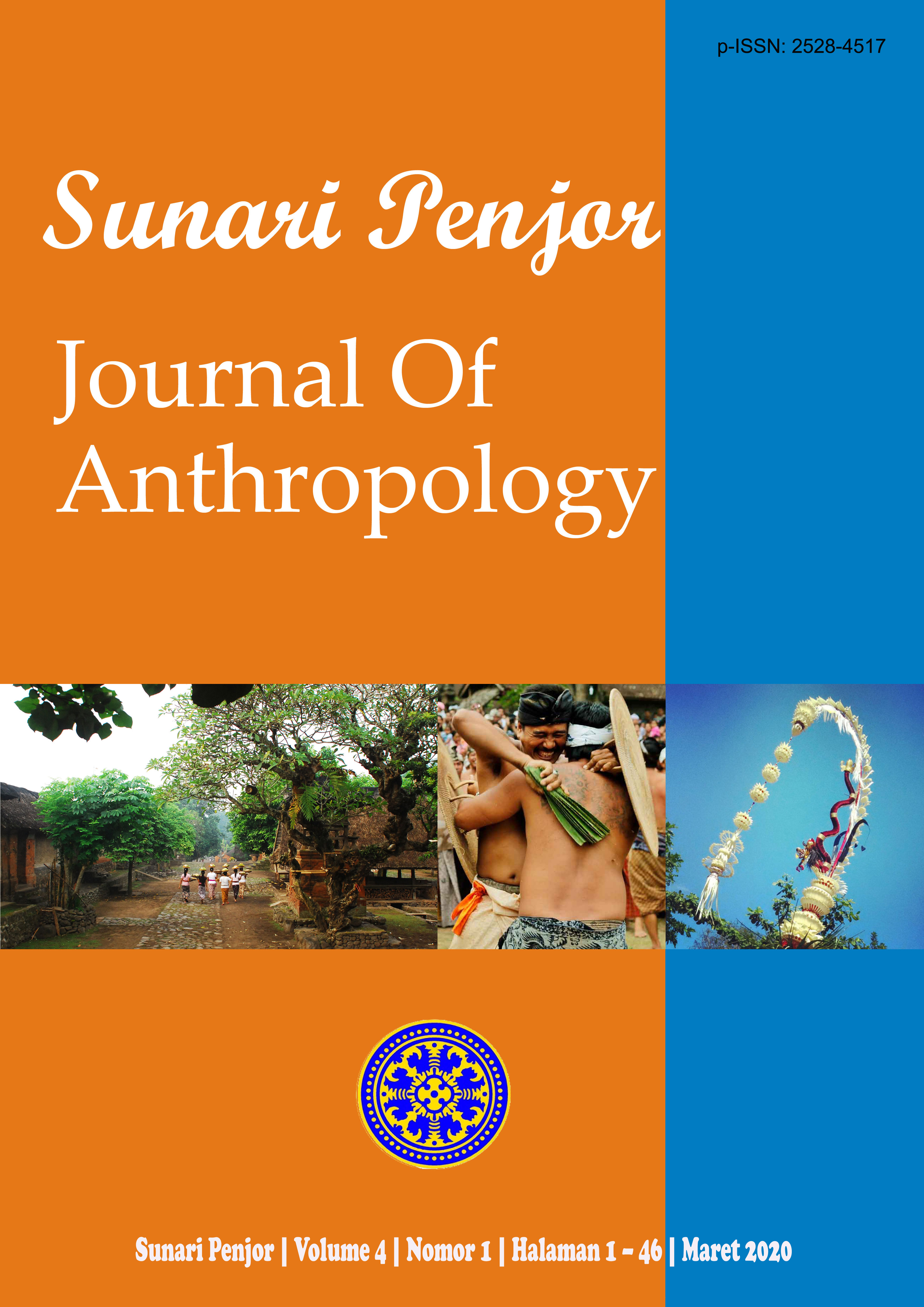Ata Sodha dalam Tarian Gawi Desa Tenda Kecamatan Wolojita Kabupaten Ende NTT
Abstract
Gawi dance’s one of the dance that has recorded as an Warisan Budaya Tak Benda (WBTB) but has not been designated as a national cultural. Literally, the meaning of the word GAWI is defined as follows: GA means reluctant or shy while WI means interesting, in the sense of uniting oneself.Ata Sodha is a poet using language of customs. Ata Sodha possess a role as a leader of Gawi dance and it belongs to a part of traditional ceremony. The probleems of this stuudy comprise of (1) How is the role of Ata Sodhain traditional ceremony Gawi dance of Tenda village community? (2) How is the perception of community regarding to Ata Sodha?. The theories being used in this research, namely role theory and simbolic interpretative theory.The concepts that are used among other: roles, Ata Sodha, Gawi dance and perception. In this reserch, descriptive qualitative method’s adopted, by the data source namely primary and secondary in which the data are collected by observing, interviewing literature review.The findings In this research points out that an Ata Sodha has an unseparable role in traditional ceremony. The brainwave that they obtain from their ancestors in form of ability to chant prayer and praise verses by using traditional language to make Ata Sodha have sufficient important role. In traditional ceremony, Ata Sodha plays the role as the lader in Gawi dance. Society expects that the existence of Ata Sodha remains exist in traditional ceremony
Downloads
References
Bauto, M. L. (2014). Perspektif Agama dan Kebudayaan Masyarakat Indonesia. Kendari: 23 (2) : 24.
Dzofir, M. (2017). Agama dan Tradisi Lokal. Jawa Tengah: 1 (1) : 113.
Eka, Y. O., Dey, Y. D., Kadafil, A. (2017). Peran Konselor Dalam Menumbuhkan Semangat Kebangsaan Melalui Tari Gawi. Ende-Flores: 1 (1) : 182.
Embon, D. (2019). Sistem Simbol Dalam Upacara Adat Toraja Rambu Solo : Kajian Semiotik. Sulawesi Tengah : 4 (2) : 3
Evadila. (2016). Tari Tradisi Dagong Pada Upacara Perkawinan Di Desa Bantan. Riau: 3 (2) : 28.
Goo, A. M. (2019). Upacara Suu Ine Mbupu Wangga Ame Uwa di Komunitas Adat Wodo watu Desa Udiworowatu Kecamatan Keo Tengah. Nagekeo: 25 (2) : 4
Gunawan, P., Syai, A., Fitri, A. (2016). Eksistensi Tari Likok Pulo. Aceh Besar: 1 (4) : 281.
Hilipito, K., Moh A., Sugiarso, A. B., Memahit. J D. (2019). Tarian Adat Kebela Daerah Bolaang Mongondow dalam Kartu Augmented Reality. Sulawesi Utara: 14 (1) : 35.
Khutniah, N. (2012). Upaya Mempertahankan Eksistensi Tari Kridha Jati Di Sanggar Hayu Budaya Di Kelurahan Pengkol Jepara 1 (1) : 2
Kleden, I. (1897). Sikap Ilmiah dan Kritik Kebudayaan.Jakarta: LP3ES.
Lail, J. (2015). Belajar Tari Tradisisnal Dalam Upaya Melestarikan Tarian Tradisional. Yogyakarta: 4 (2) : 1
Mbete, A. M. (2006). Khazanah Budaya Lio-Ende.Ende: Pustaka Larasan dan Dinas Pendidikan dan Kebudayaan Kabupaten Ende.
Nursyam, Y & Supriando. (2018). Makna Simbolik Tari Ilau Nagari Sumani Kabupaten Solok. Sumatra Barat: 28 (4) : 499
Pratiwi, C. A. (2017). Harai : Telaah Konsep Religi Koentjaraningrat. Surabaya : 5 (2) : 175
Priyoharyono, J. E. M. (2012). Indonesian Journal and Cultural Anthropology. Jakarta: 33 (3) : 189.
Retnoningsih, D. A. (2017). Eksistensi Konsep Seni Tari Tradisional Terhadap Pembentukan Karakter Siswa Sekolah Dasar, Brebes: 7 (1)
Saifuddin, A. F. (2006). Antropologi Kontemporer : Suatu Pengantar Kritis Mengenai Paradigma. Jakarta: Kencana
Sugiono. (2005). Memahami Penelitian Kualitatif.Bandung: Alfabeta
Soekanto, S. (1981). Sosiologi Hukum Dalam Masyarakat. Jakarta : Rajawali.














